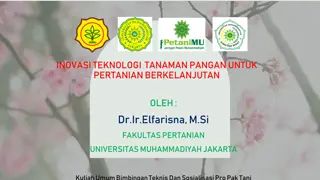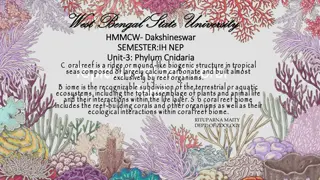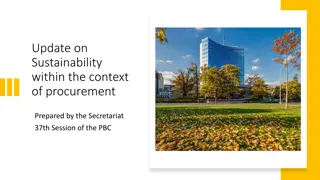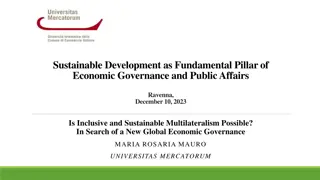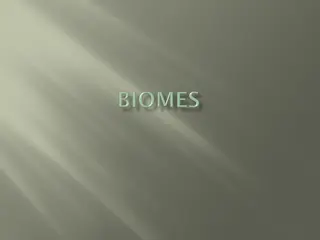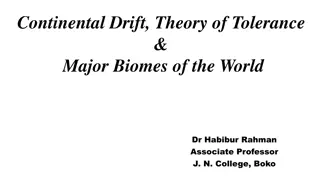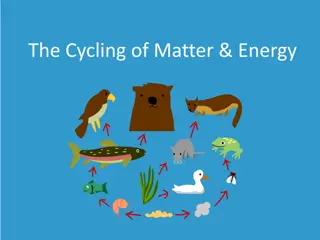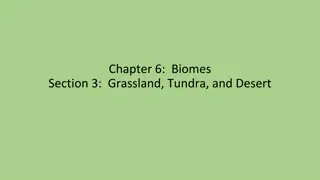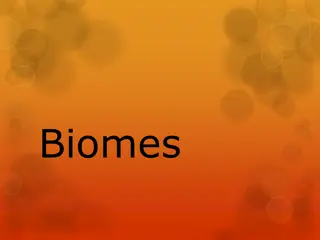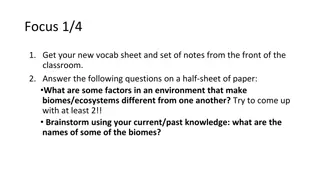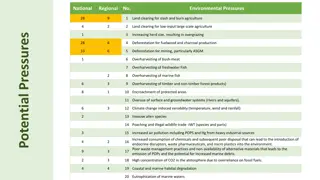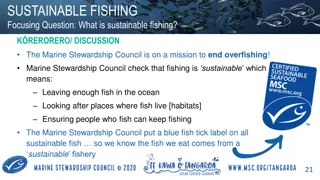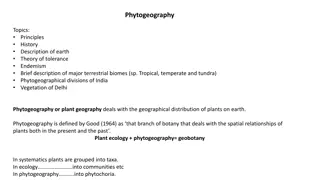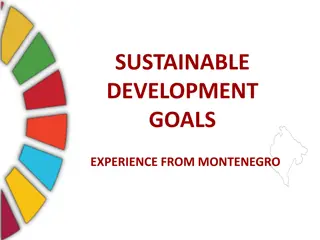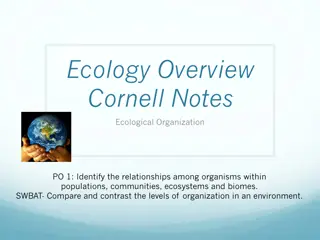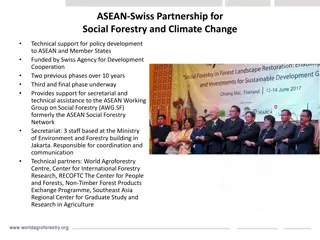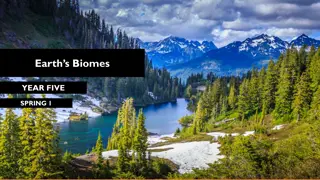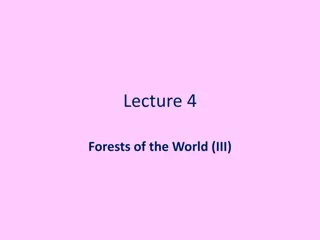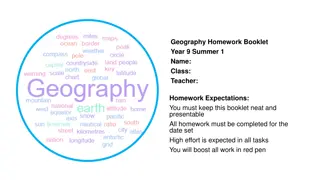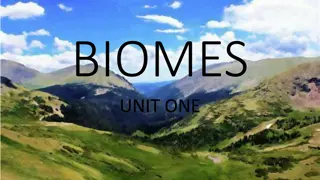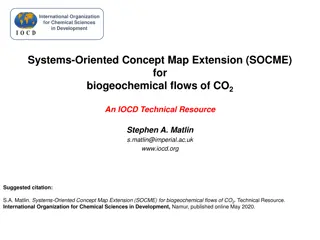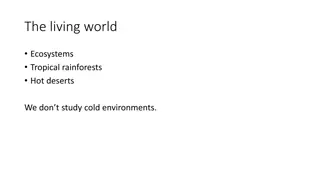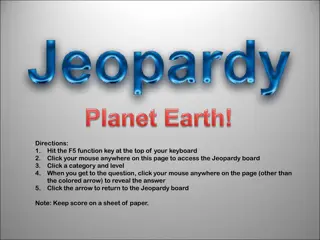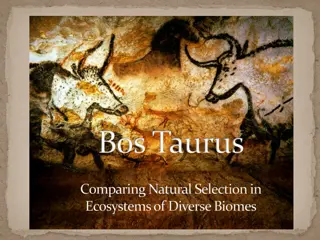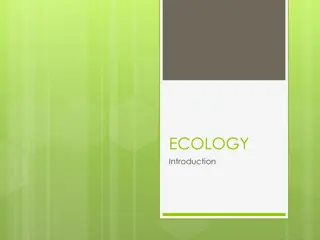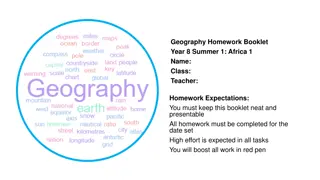Sustainable Fashion Solutions for Repurposing Formal Wear
Transforming formal wear from single-use items into sustainable fashion solutions is vital for reducing textile waste and environmental impact. This article explores the challenges of post-party formal dresses, the environmental consequences of textile waste, and innovative approaches to upcycling d
9 views • 14 slides
ELENA Grants: Supporting Sustainable Investments for a Greener Future
ELENA grants provide support for various sustainable investments, including sustainable energy projects, residential renovations, sustainable urban transport initiatives, and more. With a minimum investment requirement of 30 million, ELENA focuses on mature projects with investment returns within 3/
0 views • 30 slides
Sustainable Agriculture Innovations for Future Food Security
Dr. Ir. Elfarisna, M.Si from the Faculty of Agriculture at Muhammadiyah University Jakarta discusses innovative technologies in crop production for sustainable agriculture. The presentation highlights the three pillars of sustainable development - economic, ecological, and social aspects, along with
13 views • 24 slides
The Fascinating World of Coral Reefs and Their Biodiversity
Coral reefs are vital biogenic structures formed by reef-building corals and various marine organisms. These ecosystems, found in diverse regions like the Caribbean, Indo-Pacific, Fiji, and Bermuda, host a rich array of flora and fauna, including corals, fish, turtles, and sea snakes. The intricate
5 views • 14 slides
Sustainable Biomes for Industrial Materials Production
Explore biomes that produce industrial materials such as mineral resources and timber in Australia. Learn about the types of biomes, the impact of features on material production, and the differences between native and plantation forests for industrial timber. Discover how indigenous and introduced
6 views • 12 slides
Understanding Ecosystems: Ecological Interactions and Dependencies
Ecology is the study of how organisms interact with their environment, influencing their distribution and abundance. This exploration covers terrestrial and aquatic biomes, energy flow, environmental impacts, adaptations, and global ecosystems, emphasizing the interconnectedness of all living organi
2 views • 58 slides
Update on Sustainable Procurement in UN and WIPO Context
This update focuses on sustainable procurement within the UN and WIPO context. It discusses the evolution of sustainable procurement practices, including the integration of environmental and social sustainability pillars. The document highlights key milestones, such as the UN's definition of sustain
2 views • 11 slides
Sustainable Development as Fundamental Pillar of Global Economic Governance Reform
The need for reform in global economic governance is emphasized for achieving sustainable and shared growth. Key issues include debt burden reduction, sustainable finance increase, and international trade system improvement. International commitments on human rights and sustainable development are n
1 views • 7 slides
Exploring the Tundra and Taiga Biomes
Discover the unique characteristics of the tundra and taiga biomes, from the frozen landscapes of the tundra with its array of adapted plant and animal species to the coniferous forests of the taiga teeming with diverse wildlife. Learn about the extreme climate conditions and fascinating ecosystems
0 views • 28 slides
Continental Drift, Theory of Tolerance & Major Biomes of the World Overview
This detailed presentation explores topics like Continental Drift, the Theory of Tolerance, and Major Biomes of the World. It covers the history of the Continental Drift theory, from Wegener to Du Toit's modifications, and delves into the various terrestrial biomes that exist, including tundra, bore
2 views • 26 slides
Understanding the Cycling of Matter and Energy in Ecosystems
Explore the interconnected web of life within biomes and ecosystems, where organisms play vital roles in maintaining balance. Learn about producers, consumers, and decomposers, and how energy flows through different trophic levels. Dive into the world of primary, secondary, and tertiary consumers, a
0 views • 24 slides
Grassland, Tundra, and Desert Biomes: Exploring Earth's Diverse Landscapes
Grassland, tundra, and desert biomes are unique ecosystems shaped by varying levels of rainfall. From the grassy plains of savannas to the harsh conditions of tundras, each biome hosts a diverse array of plants and animals adapted to survive in challenging environments. Discover the distinct charact
0 views • 28 slides
Advancing Low Carbon Development in Sustainable Transport
Thierry Nervale, Deputy Director of the Transport SPC EDD Programme, highlights the importance of sustainable transport in achieving economic growth, social equity, and environmental preservation. The UN Conference on Sustainable Development underscores the central role of transportation in sustaina
4 views • 17 slides
Understanding Biomes: Climate, Ecosystems, and Threats
Biomes are large regions with distinct climates, plant, and animal communities, each consisting of multiple ecosystems. The main factors shaping biomes are temperature and precipitation, influencing the types of organisms that can thrive in each region. Tropical rain forests, for example, are critic
0 views • 27 slides
Understanding Biomes: Climate, Vegetation, and Adaptations
Biomes are vast regions defined by climate, plant and animal communities. Factors like climate, geography, and vegetation impact the unique characteristics of each biome. Understanding biomes involves knowledge of climate, geography, vegetation adaptations, and animal diversity. Changes in one part
0 views • 23 slides
Environmental Pressures and Biomes Overview
The content provides an overview of various environmental pressures such as land clearing, deforestation, overharvesting, climate change, and more. It also outlines different biomes including temperate forests, tropical grasslands, deserts, and marine ecosystems. The document aims to highlight the c
1 views • 13 slides
Understanding Sustainable Fishing Practices and Conservation Efforts
Sustainable fishing practices are crucial for maintaining healthy marine ecosystems. The Marine Stewardship Council ensures fishing is sustainable by leaving enough fish in the ocean, protecting fish habitats, and supporting fishing communities. Unsustainable fishing practices such as bycatch, shark
2 views • 8 slides
Understanding Phytogeography: Geographical Distribution of Plants
Phytogeography, the branch of botany dealing with plant distribution, encompasses principles, history, major biomes, and India's divisions. It explores phytochoria, natural floristic areas based on species distribution. The study's history dates back to Theophrastus and Linnaeus, with Humboldt and H
0 views • 7 slides
Embedding Education for Sustainable Development in the Curriculum: The Scottish College Project
Embedding Education for Sustainable Development (ESD) in the curriculum is crucial for meeting current needs without compromising the ability of future generations to meet their own needs. The concept of sustainable development encompasses social, environmental, and economic elements. Education for
6 views • 20 slides
Sustainable Development Goals Experience in Montenegro
Experience the sustainable development journey in Montenegro, featuring the creation and monitoring of the National Strategy for Sustainable Development, indicators reporting systems, EU accession processes, and institutional setup. Explore Montenegro's geographical context, population growth, GDP,
1 views • 14 slides
Understanding Ecological Organization in the Environment
Explore the relationships among organisms within populations, communities, ecosystems, and biomes. Delve into the levels of organization in different environments, from populations to the biosphere. Learn about primary and secondary succession, pioneer species, and how environments form. Discover th
1 views • 19 slides
Sustainable Agroforestry Initiatives in ASEAN Region
Sustainable agroforestry initiatives in the ASEAN region are supported by partnerships like the ASEAN-Swiss Partnership for Social Forestry and Climate Change, focusing on policy development and technical assistance. The Mekong Expert Group on Agroforestry is dedicated to knowledge sharing for food
4 views • 4 slides
Exploring Ecosystem Dynamics: Food Chains, Energy Pyramids, and Trophic Levels
An exploration of key concepts in ecosystem dynamics, including food chains, energy pyramids, secondary consumers, and trophic levels. Discover the interconnected relationships between organisms in an ecosystem and the vital role of key species. Dive into the differences between food chains and food
0 views • 16 slides
Understanding Ecosystems and Global Biomes: A Comprehensive Study
Explore the fascinating world of ecosystems, producers, consumers, and the vital role of decomposers within these intricate systems. Delve into the impact of environmental changes like deforestation on ecosystems. Discover the geographical features and significance of hot deserts, tropical forests,
0 views • 26 slides
Understanding Biomes: Concept, Classification, and Factors
Biomes are large natural ecosystems encompassing plant and animal communities shaped by shared physical climates. They are classified based on climate, vegetation, soil-water, and heat availability, encompassing diverse environments like deserts, forests, savannas, and oceans. The concept of biomes
0 views • 6 slides
Exploring Earth's Biomes in Year 5 Spring
Delve into the fascinating world of Earth's biomes through an engaging learning review in Year 5 Spring. Discover diverse ecosystems like tundra, desert, temperate broadleaf forest, tropical forest, grasslands (Savannah), and coniferous forest (Taiga). Enhance your knowledge of different climates, p
0 views • 11 slides
Understanding Ecosystems: A Comprehensive Guide
An ecosystem comprises both living (biotic) and non-living (abiotic) factors interacting in a specific area, with populations, communities, and ecology playing essential roles. Abiotic factors like temperature, water, sunlight, and wind influence species distribution, while biomes categorize ecosyst
1 views • 23 slides
Explore Biomes: Test Your Knowledge with Biome Sorting
Delve into the fascinating world of biomes with an interactive activity to test your understanding. Identify different biomes, their characteristics, plant and animal adaptations, and where they are found. Review key concepts through engaging questions and images.
0 views • 8 slides
Exploring the Biodiversity of Tropical Rainforests
Discover the lush world of tropical rainforests, rich in unique flora and fauna. Learn about their complex structure, diverse vegetation, and the incredible array of species they support. Delve into the fascinating characteristics and the importance of these biomes in sustaining global biodiversity.
1 views • 24 slides
Understanding Environmental Hazards and Management
Exploring major hazards management, geology perspectives, ecological concepts, natural environmental hazards, classes of natural hazards, and introduction to environmental hazards management. The content covers ecological levels, abiotic factors, biomes, environmental degradation, and more.
0 views • 10 slides
Geography Year 9 Summer Homework Booklet
This Geography Year 9 Summer Homework Booklet covers topics such as Global Biomes, Location and Climate, and Brazil's Tropical Rainforests. Students are expected to define key terms, study maps, answer questions, and label countries to demonstrate their knowledge and understanding of various geograp
0 views • 11 slides
Understanding Biomes and Ecosystems in Nature
Exploring the concept of biomes and ecosystems, the interaction between living and nonliving elements in nature, the adaptation of species to their habitats, and the different types of biomes like tundra, forests, grasslands, deserts, and aquatic biomes. The extreme conditions of tundra and deserts
0 views • 18 slides
Understanding Carbon Storage in Biomes and Ecosystems
Explore the intricate carbon cycle within terrestrial ecosystems, focusing on carbon storage in biomass, litter, and soil. Delve into the differences in plant characteristics among various biomes and their impact on carbon sequestration. Gain insights into the distribution of tropical rainforests an
0 views • 13 slides
Understanding Ecosystems: Climate, Biomes, and Management
Explore the relationship between climate and biomes on a global scale, focusing on hot semi-arid grasslands and one other biome. Learn about the physical processes linking living and non-living components in ecosystems, such as nutrient cycles and food webs. Discover how small-scale ecosystems in th
0 views • 4 slides
Systems-Oriented Concept Map Extension for Biogeochemical Flows of CO2
The Systems-Oriented Concept Map Extension (SOCME) explores the biogeochemical flows of CO2, detailing interactions within the ocean and land subsystems, including factors such as uptake by different biomes, anthropogenic CO2 generation, deforestation effects, and energy production contributions. It
0 views • 6 slides
Understanding Global Ecosystems and Tropical Rainforests
Ecosystems exist at various scales, influenced by both living and non-living components. Global atmospheric circulation shapes the distribution of biomes like tropical rainforests and hot deserts. Tropical rainforests, with distinct environmental characteristics, face threats like deforestation. Sus
0 views • 15 slides
Discovering Earth's Biomes and Climate Through Jeopardy Questions
Explore Earth's diverse biomes and climate concepts by playing a virtual Jeopardy game. Test your knowledge on topics such as deserts, biomes, climate, atmospheric layers, and elemental compositions of air. Learn interesting facts about penguins, living organisms in the ground, winds, and more.
0 views • 27 slides
Comparing Natural Selection in Diverse Biomes: Spanish Cattle Adaptations
Explore the natural selection of Spanish cattle in desert, swamp, and grassland ecosystems. Compare characteristics of Cracker and Chinampo cattle, highlighting their adaptations for survival in different biomes. Discover how these species thrive in challenging environments through unique physical a
0 views • 11 slides
Exploring Ecology: Interactions and Environments
Dive into the world of ecology, where organisms interact and rely on each other and their surroundings. Understand the concepts of populations, communities, ecosystems, biomes, and the biosphere. Explore the vocabulary of ecology, from individual organisms to entire biomes. Learn about food chains,
0 views • 14 slides
Exploring African Biomes and Stereotypes in Year 8 Geography Homework
In this Year 8 Geography Homework booklet, students delve into the diverse biomes of Africa, challenge stereotypes, and work on climate studies. Tasks include defining stereotypes, mapping misconceptions, studying African biomes, and analyzing the climate of Algeria. The assignments aim to broaden s
0 views • 10 slides


